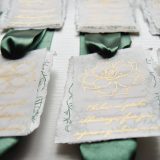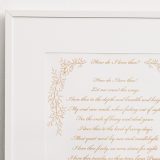CALLIGRAPHY RESOURCES & MATERIALS

Detailed below are some of my recommended nibs, holders, papers and inks, and things that I have found really useful to my modern calligraphy journey.
NIBS
I’m sure these will change from time to time, but for me my favourite nibs are:
Nikko G – a firm favourite with many calligraphers and the perfect nib to start with. It is strong and sturdy and you really have to press quite hard which is great if you are heavy handed (which at first you will be). It gives lovely lines and isn’t too sensitive to varied mediums so will work well with watercolour papers or if you are writing on other textures.
Brause 361 Steno (Blue Pumpkin) – this is such a pretty nib and has a lovely flex which will produce great lines for your downstrokes but also can produce the thin upstrokes that you will be craving. I would consider this nib a softer version of a Nikko G or Zebra G but not as flexible as the Brause Rose or the Brause 66 EF.
Brause 66 EF Extra Fine – this is a teeny tiny nib but my goodness it packs a punch – it has a big flex which will create fantastic deep lines and then wonderful thin lines on your upstrokes. A great nib if you are working on larger fonts, it does need refilling more frequently due to it’s size and I found didn’t fit very well with many of my pen holders apart from the Tachikawa Comic Pen.
Brause Rose – this nib has a pretty indented rose which just makes you want to use it. At the moment I am a little heavy handed with it and like the Brause Rose because it has a great flex which gives you beautiful lines. Certainly one to purchase almost just to look at!
Zebra G – this is very similar to the Nikko G and another favourite of mine, a definite ‘go-to’ nib for me at the moment and feels so natural when I am using it.
I am always trialling new nibs so I will add them to my collection here.
HOLDERS
When I first started I bought a very simple cork pen holder which has served me very well so if you are just starting out I would say that this is a perfect holder to start with. I did find that my Brause 66 EF kept slipping out as it seemed that the petals (these are the metal prongs that hold the nib in place) weren’t a tight enough fit. This might just be me but after a lot of searching online I came across the Tachikawa Comic Pen Nib Holder – Model 40 – I did have to order it from a Japanese supplier but it came within a week and I haven’t looked back. It is a wonderful pen holder and has two rings so you can fit the small Brause nib inside and bigger nibs such as the Nikko G on the outer ring. I also like the fact it has a plastic protective cap so you can take it anywhere with you with a nib fitted inside and won’t get damaged.
I have recently purchased the Speedball Oblique holder from Blots Pen and Ink Supplies which has a 360 degree circle so that it will work for both left and right handed users which after spending so much time using a straight pen feels a bit strange but seemed to work with my writing so I will persevere and let you know how I get on.
I have seen some beautiful wooden holders all over instagram and I think that is going to be on my Christmas list but for now these pens are serving me perfectly well.
INKS, PAINTS AND PAPERS
Inks
For my day to day practising I use the Speedball India Ink which is fine for me. It does tend to bleed on a lot of papers but is ok on the Rhodia pads. I have found that it will bleed on some card and isn’t great on watercolour paper.
Higgins Eternal ink is a great black to use and doesn’t seem to bleed as much. You can use it straight out of the bottle and it’s really good quality. I have also heard that Sumi Ink is very good and some calligraphers say to use Iron Gall ink which was the traditional ink to use many years ago.
My absolute favourite white ink is the Dr. Ph. Martin’s Bleedproof White, it is very gloopy to start with and you do need to mix it with water. I purchased some dinky dips (see below) which I transfer some into and add water as necessary, you are looking for a good flowing consistency but not too watery. I use a pipette or dropper to add my water so as not to add too much in one go. It gives a wonderful opaque quality and simply ‘pops’ against dark card or envelopes.
Other inks I have used are from the Windsor and Newton Acrylic Ink range – what is wonderful about these inks is that you can mix the colours together because they are part of the same collection and will mix beautifully to create new colours. This is very useful if you are trying to colour match to a specific pantone or swatch. They come with a handy dropper which is really helpful for both mixing and transferring the ink to a dinky dip pot.
Paints
Recently I have started playing around with watercolours and brush lettering which is wonderfully creative and freeing. My go to items for this have been the Pentel Aquash Water Brush Pens – I bought the pack of three which have been brilliant as each nib is a different size (small, medium and broad) so you can create wonderful brush lettering effects with each one. They have a chamber which you can fill with water or ink and you just squeeze the chamber when you want to dilute the colour with water, or in the case of the ink you squeeze the chamber to release more ink as you are writing.
As I wasn’t sure if watercoloring was going to be for me I didn’t want to spend a lot of money on supplies so I bought the Winsor & Newton Cotman Watercolour Sketch Pocket Box which came with watercolour pans and a travel brush in a travel box which has been amazing and the colours have lasted for a long time. The pans seem to work better than the paints from what I have read on various tutorial but I haven’t played with paints yet.
If you are looking for beautiful shimmering golds and silvers then you can’t beat the FINETEC M600 Pearl Metallics Palette, after seeing this on an American calligraphy website every link was to American suppliers but I finally tracked it down on the Penman Direct website – it does seem like a lot of money but they last for ages and once you have the palette you can purchase individual pans to replace the more popular colours. To write with these using a dip pen simply activate the pan with some water and then paint the back of the nib to fill up the reservoir with the paint and off you go. It looks so pretty against candlelight and shimmers in the sun.
Papers
Something that has surprised me is the amount of papers that say they are calligraphy paper but they either bleed or soak through and just aren’t good enough quality. A good rule is to go for paper that is over 120gsm (at least) and a smooth texture. Some nibs are so fine that they pick up the tiniest of fibres which can ruin not only the nib but also your writing. For practising I would recommend any of the Rhodia Pads, my favourite at the moment is the Rhodia Dot Pad because it gives me places to align my writing without losing the flexibility of modern calligraphy. This is particularly helpful when you are practicing getting the perfect ‘bounce’ on your letters.
I also have through trial and error found the perfect watercolour paper to work with. Whatever you choose make sure it is at least 300Gsm and cold pressed. If you are looking for a the perfect paper for your final pieces of work then the best has to be Bristol Paper – it’s not cheap so make sure you complete all your designs on sketch paper and when you are completely happy transfer to Bristol Paper either by eye or using a lightpad / box (see below). Make sure that with any of your projects you allow enough time for the ink to dry, I was bitterly disappointed once when I held up a piece to show someone only to find a small bead of ink working it’s way down the page!
Other Useful Equipment
Lightpad / Lightbox – After struggling for too long to try and see guidelines and practise templates with a bright light I decided to invest in a very simple lightpad / lightbox and I haven’t looked back. I’m sure in the future I will upgrade to one with more features but for simply ‘doing the job’ this is the one I purchased.
Dinky Dips – ‘What on earth is that?’ Was the first thing I thought when watching a great tutorial on SkillShare but I have to say I am converted, they are cute little plastic pots that sit in a wooden tray so that you don’t knock them over. Perfect not only for mixing colours but also being able to see how much ink you are putting on your nib which makes it so much easier than guessing – especially with black ink and smaller nibs. It took me some time to track them down but I finally found them on Blots Pen and Ink website, click here to visit the dinky dips page.
Ruler – it may sound silly but investing in a decent ruler saves you so much time in the long run – I use a clear ruler so I can see through my work but you can use whatever you wish. It’s a bit like the saying ‘measure twice, cut once’ but in our case it’s ‘measure twice, write once’.
Pencils – a decent pencil is so important and a variety of sizes can be so helpful when you are sketching your design, when you want to create a faux calligraphy style in your sketch a thicker pencil will save you time and effort.
A good rubber – some rubbers can damage the paper or card you are working on and also can affect your inks, make sure you test the rubber on your chosen card or paper before using against your lovely work. I use a white one. I’ve also heard that mechanical rubbers are very good as well for smaller areas.
Chalks – I have talked a lot about calligraphy equipment but writing on a blackboard is a wonderful way to complete a wedding or event. You can choose to write with chalk pens or use a simple pack of white or coloured chalks to create your wonderful design.
Cutting Mat – Not only useful for cutting but also helpful when lining up envelopes to make sure your are writing on a line – exceptionally helpful when centering an address on envelopes.
I hope you have found this information useful in some way and I hope you enjoy your journey into modern calligraphy!
Please note: some links in this post contain affiliate links to Amazon, however I never recommend anything I haven’t used myself.








